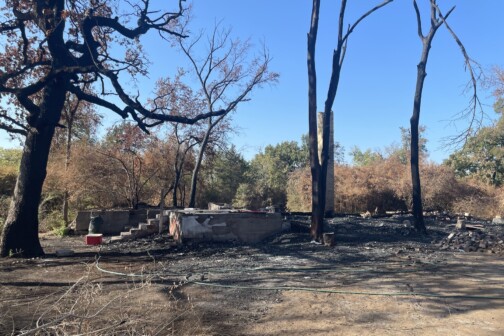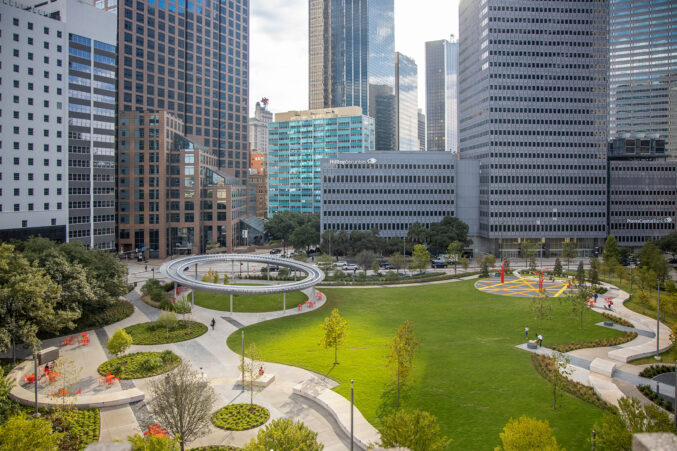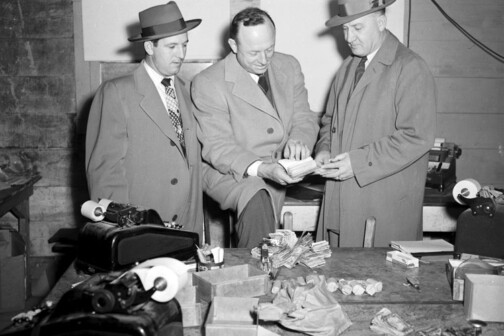A piece of century-old Dallas history now lies in ashes in the Great Trinity Forest. The Lock Keeper’s House—or the Lock Keeper’s Quarters, as it was known in the early 1900s—caught fire in July and was consumed by flames, leaving only a concrete slab, a chimney, charred trees, and scattered ashes on a bluff above the Trinity River.
It was a surreal, obscure site that was difficult to access, a two-story Victorian-style house that pointed toward the McCommas Bluff preserve just south of the Trinity River Audubon Center. You can get there by following a concrete path from the Great Trinity Forest Gateway and Horse Trail, near Interstate 20, off Dowdy Ferry Road. You’ll still have to look out for the narrow path that leads up to the bluff, but the house would have been visible from points north. It was an eerie, unexpected structure ideal for drone footage and spooky music.
Fifty or so feet below the house, the river water rushes over the Trinity’s first lock and dam, one of the few physical reminders of a time when early Dallas planners envisioned the city as an inland port accessible to barges carrying goods to and from Galveston and Houston.
“It’s one of those things where you blame yourself. Why couldn’t I get anyone to buy it?” said Ben Sandifer, my tour guide for the day. Sandifer, an accountant whose passion lives in these woods, said it has been difficult to return to the site to see the dust of history.
Sandifer is a vocal advocate for the forest. Code violations, illegal dumping, poaching, clear-cutting—he has seen it, and he reports it. He viewed the lock keeper’s house as one of the ways we could understand how this city began. Ideally, the structure would’ve been moved and preserved, maybe opened up as a museum of sorts.
Jason Evans, a spokesman for Dallas Fire-Rescue, said firefighters were dispatched to a grass fire in the forest at 1:08 a.m. on July 15. Concrete barriers had been set up around the property to keep ATVs out, so fire trucks had difficulty getting in. By the time firefighters gained access, the house had already collapsed and “had been burning for an unknown amount of time.” Dallas police launched its Air 1 helicopter to provide reconnaissance. The blaze was extinguished at 7:02 a.m., about six hours after the call.

“Homeless individuals were known to reside in the house, but there was no one there when firefighters arrived,” Evans wrote. “Investigators’ efforts were significantly hampered by the extensive damage left behind. That, combined with there being no witness to the beginning stages of the fire, among other factors, resulted in the cause of the fire being listed as undetermined.”
The house was likely built in the early 1900s for the lock keeper and his family. The lock keeper’s job was to move boats along the river by controlling the level of water in the lock chamber. The lock and dam were built in 1909. McCommas Bluff is a Texas Historic Landmark, the single limestone bluff on the Trinity River. In the late 1800s, the rising price of transporting goods on the railroad spurred the city’s leaders to consider harnessing the Trinity River to move timber and cotton. It was among the earliest failures of Dallas’ elite to bend the river to match their ambitions.
In the early 1900s, the U.S. Army Corps of Engineers proposed dredging the river and installing 37 locks and dams from Dallas to Galveston. As the writer Laray Polk chronicled for us earlier this year, the feds issued appropriations “at regular intervals” through 1915. In 1906, the Dallas Morning News reported that the government-owned steamboat Frank P. Holland left the city for McCommas Bluff hauling a cargo of lumber “for use in the construction of the lock keeper’s quarters.”
But it soon became clear to the Corps that the river’s “physical features are of the most unfavorable character” for commercial navigation. The work stopped, the money dried up, and voters killed the idea 50 years ago in a bond election championed by Dallas’ leaders in the 1960s.
“The idea of turning Dallas into an inland port ran through that one spot,” Sandifer said, walking through the ashes.
The history of this space predates the lock and dam. Native American arrowheads have been found nearby. A 1978 archeological survey quotes the then-resident of the house, Mrs. John B. Cooke, as saying a neighbor “walked the entire ridge and found repeated evidences of prehistoric materials.” (Cooke said she bought the land “in the name of their church and the church actually controls the land.”)
“This locality is the highest point for miles along the edge of the river and would have provided an excellent area for a prehistoric settlement,” the report reads. It notes that the house is the “remains of a government checking station for boats leaving Ennis and traveling up the Trinity.”
Cooke bought the property from a veterinarian named Dr. Hamitur whose son operated a traveling circus. He “boarded an elephant and baboons in the stables that originally went with the house.”
Sandifer said he spoke with the most recent occupant of the house, a man named William Wesley Thompson, who died last May. Sandifer said he got the feeling that Thompson was a recluse, living out his days in this old house in the middle of the forest. An obituary reported that Thompson was a naval vet who was stationed on the U.S.S. Intrepid, an aircraft carrier that was commissioned in the Pacific after the attack on Pearl Harbor. One of the few remaining items was an old photo of Naval sailors, which rested on a charred tree trunk.

As Evans noted, there were sleeping bags and other personal items near the path up to the house.
“I always thought that when I come out here, the next time I come back it will all be gone,” Sandifer said.
The house is gone, but the lock and dam are still there. Charles Allen, a tour guide who owns Trinity River Expeditions, said the lock chamber precedes a 4-foot drop that could trap canoers and kayakers in a recirculating wave. The right side is the base of the old dam, where water is rarely high enough to traverse. Metal and rebar line the river floor, and rods jut out in places. Getting around it requires portage, which can take hours. (Allen once wrote an essay for us about traversing this portion of the Trinity on his way down to the Gulf of Mexico.)
“The river and its inaccessibility help protect a lot of the things about the river, including historical sites,” Allen said. “But it didn’t protect this one. It was subject to human influence and neglect. We lose a part of our history.”
Author







